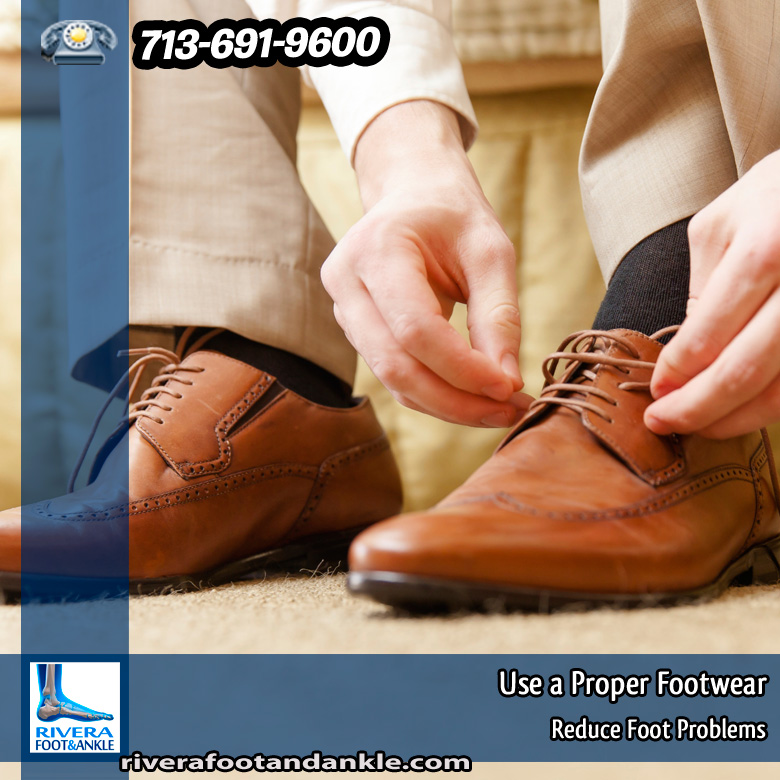Use a Proper Footwear
Reduce Foot Problems
Children’s Shoes - When a child begins to walk, shoes generally are not necessary, allowing an infant to go barefooted in doors, or to wear only a pair of socks, helps the foot grow normally and develop its muscles and strength, as well as the grasping ability of toes. As children grow more active, and their feet develop, the need for shoes becomes apparent. It becomes necessary to change shoe sizes at a pace that frequently surprises and even dismays parents, to allow room for growth.
When purchasing shoes for children, remember these tips:
- Examine the shoe itself. It should have a firm heel counter (stiff material on either side of the heel), adequate cushioning of the insole, and a built-in arch. It should be flexible enough to bend where the foot bends at the ball of the foot, not in the middle of the shoe.
- The child’s foot should be sized while he or she is standing up with full weight-bearing.
- There should be about one-half inch of space (or a thumb’s width) between the tip of the toes and the end of the shoe. The child should be able to comfortably wiggle his or her toes in the shoe.
- Have the child walk around the store for more than just a few minutes wearing the shoe with a normal sock. Ask the child if he or she feels any pressure spots in the shoe. Feel the inside of the shoe for any staples or irregularities in the glue that could cause irritation. Examine where the inside stitching hits the foot. Look for signs of irritation on the foot after the shoe is worn.
- Shoes should not slip off at the heels. Children who tend to sprain their ankles will do better with high-top shoes or boots.
- Both feet should be measured, and if two different sizes, shoes should be chosen that fit the larger foot best.
Women’s Shoes - Women inflict more punishment on their feet in part from improper footwear that can bring about unnecessary foot problems. Some of the problems result from high-heeled shoes (generally defined as pumps with heels of more than two inches). Doctors of podiatric medicine believe such heels are medically unsound, and attribute postural and even safety problems to their use. To relieve the abusive effects of high heels, women can limit the time they wear them, alternating with good quality sneakers or flats for part of the day.
They can also vary heel height. There are comfortable and attractive “walking” pumps (also called “comfort” or “performance” pumps) for work and social activities, that blend fashion considerations and comfort, offering pumps with athletic shoe-derived construction, reinforced heels, and wider toe room. Activity has a bearing on the considerations; wearing the right shoe for a particular activity is probably as important a factor in the choice of shoes as any.
Perhaps the best shoe for women is a walking shoe with laces (not a slip-on), a polymerized composition sole, and a relatively wider heel with a rigid and padded heel counter, no more than three-quarters of an inch in height.
Men’s Shoes - The best shoes for men are good quality oxford styles, shoes ordinarily associated with wing-tip or cap toe designs. Also suitable are slip-ons, dressy loafers, and low dress boots. Men as well as women should buy shoes for work, leisure, and special activities, matching the shoe to the activity. Male (and female) office workers should earmark three to five pairs of shoes for business hours general oxfords and loafers for men; pumps and oxfords for women. Cushioned-sole shoes that give good support are essential for those who spend most of their working days on their feet.
There is no question about the need for foot protection for those who work in heavy industry. Safety shoes and boots those that are waterproof or water-resistant, with insulated steel toe caps and soles of non-conducting materials help prevent injuries to the feet, and reduce the severity of injuries that do occur.
Source: podiatrists
RIVERA FOOT & ANKLE: At Orlando H.Rivera DPM, our priority is to deliver quality care to informed patients in a comfortable and convenient setting. When you have problems with your feet, you need to turn to a podiatrist who listens and responds… an experienced doctor who knows the field and can effectively diagnose and treat your needs… a friendly physician who counsels you on the best ways to maintain and improve your health. Our physician(s) meet all these criteria. Plus, you benefit from a dedicated team of trained professionals who give you the individualized attention you deserve.

Food and Ankle Surgeon Houston
Keywords: Foot and Ankle, Dr. Orlando Rivera, Advanced Foot & Ankle Specialist, Foot and Ankle Podiatry, Houston Food & Ankle Surgical, Treatment of Foot and Ankle, Foot & ankle specialists, Podiatrist in houston, podiatrist in houston, Orlando H.Rivera DPM, Houston Foot Doctor, Food and Ankle Surgeon Houston, Ankle and Foot Specialist Houston, Podiatrist Houston, Foot Pain Houston



